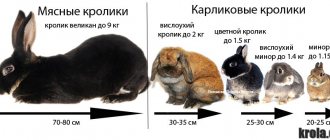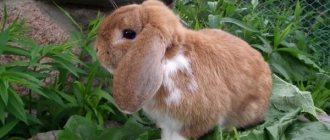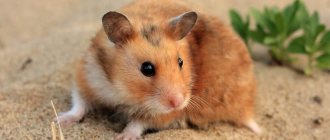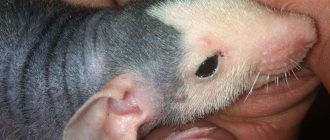Care and maintenance
African pygmy hedgehogs are not capable of living in their natural environment. Decorative animals cannot tolerate low and high temperatures. Therefore, it is necessary to maintain a certain microclimate in the room. The temperature there should be between 20-25°. If this indicator drops to 15°, the animals will hibernate.
Cage and filler
A decorative exotic living in an apartment needs a spacious cage with a solid bottom measuring at least 60 x 60 cm. It must be equipped with strong, thick bars through which the pet cannot get out.
It is recommended to cover the floor with a uniform layer 1.5-2 cm thick of birch sawdust, granulated paper or special filler. The filler needs to be changed as it gets dirty, but at least once a week.
African pygmy hedgehogs are quite shy, so the cage must have a house in which they can hide. It is also recommended to install a running wheel with a diameter of about 30 cm, a well-fixed drinking bowl, a heavy feeder and a tray.
The prickly animal is a big fan of entertainment. You can buy tunnels, balls and bells as toys for your animal.
Hygiene
In order for a decorative animal to have a neat appearance, it must be properly cared for. To eliminate parasites, heavy dirt and unpleasant odors, your pet needs to be bathed. It is recommended that the animal undergo bathing procedures no more than 1-2 times a month.
The pet is slowly immersed in a basin of warm water, carefully supported by the upper part of the body. First, thoroughly wash the paws and stomach, and only then begin to treat the back.
The pet's spines are carefully washed with a toothbrush and baby shampoo. Upon completion of the procedure, the animal is thoroughly rinsed, wrapped in a towel and waited for it to dry.
Taming
For a pygmy hedgehog to become a true friend, it needs to be educated. You can influence the character of a prickly pet if it is not yet 6 months old. Since the animal sleeps during the day, it is better to get acquainted with it in the evening. In order for an African hedgehog to get used to a human voice, you need to talk to him quietly and affectionately for 20 minutes a day.
To accustom it to the owner's smell, any item of the owner is placed in the animal's cage. And in order to establish close contact, they try to feed the pet more often from the palm.
When the animal gets a little used to its owner, you can try to lift it by its abdomen. If the pet produces thorns, it is handled with a towel or blanket. The animal must not be picked up from above. In order for the pet to calmly accept tactile contact, the palm is extended towards it from the side of the head. Then the animal will see her and calm down.
Hygiene
Aside from being sensitive to temperature, hedgehogs are relatively easy to keep.
You should bathe your hedgehog once a month with baby shampoo, a toothbrush and warm water. It is important to be careful when cleaning your hedgehog's belly as this is your hedgehog's exposed skin and is his most sensitive area. In addition, your hedgehog should have its nails trimmed frequently. If the claws are too large, he may get hurt. There have been several reported cases of hedgehogs scratching their eyes and causing significant injury to themselves. When trimming a hedgehog's nails, keep in mind that they are very similar to a dog's nails in that they contain some skin. Therefore, this should be done carefully and best after bathing, as the claws will be softer. Nails can be trimmed with cuticle scissors or baby scissors.
Hedgehog after bathing
Cages should be cleaned every two weeks and bedding changed as often. The wheel needs to be cleaned every day as most hedgehogs tend to do what they need to do on the wheel.
How much does it cost to keep an African hedgehog?
On the Russian market, the cost of pygmy hedgehogs with a regular color from a nursery starts from 6 thousand rubles. What affects the price? For a large cage you will have to pay about 3 thousand rubles. For a silent wheel they will ask for 1.5 thousand rubles, if made to order, delivery from the USA will cost about 75 dollars. A package of food for pet hedgehogs for half a month costs 600 rubles.
In addition, the price is affected by the gender, type and color of the pet. So, a domestic hedgehog with a classic color will be cheaper. For rare colors they will ask for more. For each hedgehog in a specialized nursery, a certificate is issued, which indicates the origin and instructions on the contents.
On the Internet, nurseries have posted prices for healthy hedgehogs with pedigrees. The pets are tame, socialized, and do not experience fear when they see dogs, cats, or children.
- Pygmy hedgehog Bendetto (male) – 10 thousand rubles.
- Dwarf hedgehog Gedeminas (male) – 12 thousand rubles.
- Hedgehog Hans (male) – 10 thousand rubles.
- Hedgehog Dionysus (male) – 12 thousand rubles.
- Belle the Hedgehog (female) – 15 thousand rubles.
Where to buy
Nurseries
It is important to inspect nurseries. Nurseries are often considered to guarantee quality
Unfortunately, this is not always true. For many breeders, the first priority is making a profit from sales; proper living conditions and medical care are not always provided.
Nurseries are often considered a guarantee of quality. Unfortunately, this is not always true. For many breeders, the first priority is making a profit from sales; proper living conditions and medical care are not always provided.
Adviсe:
- Monitor nurseries that breed hedgehogs, compare them, read customer reviews. Don’t stop at the first one you come across; there’s no need to rush in this matter.
- If possible, go to several nurseries, look at the conditions of detention, talk to the breeders.
- The animal must have all the necessary documents: passport, vaccination certificates.
Private owners
Is it worth buying a hedgehog secondhand? Of course, you can save money on this, or even get a “bun with thorns” for free, that is, for nothing. But such an acquisition may also have quite a few disadvantages:
- there is no guarantee that the animal is healthy, and it will turn out just like the proverb that “the miser pays twice”;
- Your new pet has already formed habits that will be difficult to correct.
Pet stores
This may seem surprising, but you shouldn’t buy hedgehogs at a pet store, and there are many reasons for this:
- Housing conditions are often not met: animals are disturbed by noise, bright light, and there is no division by gender.
- The animals are not socialized; they are completely wild and afraid of people.
- Animals are often born as a result of inbreeding and have a whole bunch of genetic diseases.
Have you decided to get a hedgehog?
Yes No, not yet...
Diseases
Hedgehogs are prone to many diseases, including cancer and Wobbly Hedgehog Syndrome (WHS). Some symptoms of WHS resemble those of multiple sclerosis in humans, so the condition in animals can be compared to what patients with multiple sclerosis experience. These include the inability to move normally, tremors of the limbs, staggering when walking, etc. A possible cause of WHS is a genetic defect that allows the virus to attack the hedgehog’s nervous system.
The nose can exhibit a variety of alarming symptoms, especially respiratory illnesses such as pneumonia. In many cases, the form of pneumonia that affects hedgehogs is bacterial in nature. When acted quickly, antibiotics can have a very positive effect. Observable signs include blisters, excessive mucus production, or persistent sneezing.
What color are pygmy hedgehogs?
The color of dwarf African hedgehogs is different and very diverse. In pet stores and hedgehog breeders (yes, there are such things too) you can find the following “war paints”:
- Hedgehogs with a black or salt-and-pepper color have almost all of their spines dark, as are their ears and mask;
- Gray urchins have either dark gray or dark brown spines. The ears are dark gray and the mask is black;
- The “chocolate” color suggests dark brown needles, light gray ears and a light brown mask;
- Brown urchins have oak bark colored needles, pink ears and a light brown mask. Representatives of this color do not just have black eyes - they have a blue edge;
- With the “cinnamon” color, hedgehogs have light brown spines, pink ears and dark ruby eyes. The mask is practically invisible;
- With the “cynacott” color, fragmentary coloring of the needles is observed: some are light brown, some are pale beige. The ears are usually pink, the mask is invisible;
- “Champagne” hedgehogs have pale beige needles and light ears, and scarlet eyes;
- The “pinto” color is also found - in these hedgehogs, some of the needles are devoid of pigment (they are partially albino).
And the last color variety is a complete albino. These hedgehogs have snow-white needles, scarlet eyes and no mask. Such white hedgehogs are quite rare.
Health and life expectancy
In their natural environment, wild hedgehogs rarely live more than 5 years. They die from disease, hunger, or become victims of predators. Some animals that hibernate do not come out of it and die. If you bring home a forest hedgehog, it is unlikely to live for many years, despite good care. The immunity of such an animal is already undermined by numerous diseases, and it is almost impossible to tame an animal from the forest.
Ornamental hedgehogs live longer, primarily due to the lack of threat from wild animals. The average lifespan of the animal is 10-12 years. A loving owner can extend the life of a pet by creating comfortable conditions for it and preparing a properly balanced diet. There are cases where pet hedgehogs lived for more than 15 years because they were well cared for.
Interesting Facts
It would seem that what could be special about ordinary hedgehogs? Acquaintance with them begins in childhood, with children's fairy tales. All kids know that hedgehogs need thorns to prick mushrooms and apples... And when they notice danger, hedgehogs almost instantly curl up into a tight ball. What else is known about hedgehogs?
Hedgehogs are recognized as the most ancient mammals. They inhabit almost all natural areas (except for heavily wetlands and permafrost). There are 17 species of hedgehogs in total.
Hedgehogs carry mushrooms and apples on their backs, impaling them on thorns, only in cartoons and children's books. In nature they don't do this.
Despite the fact that some species of hedgehogs can run fast (such as long-eared hedgehogs), they practically do not hunt mice, since even the fastest members of the family cannot catch up with a mouse.
During the winter, hedgehogs hibernate. In order to safely survive the winter in a dormant state, the animal must weigh at least 500 g. The temperature of the “home” where hedgehogs spend the winter does not fall below zero even in severe frosts. In the animal itself, the body temperature approaches 0, and the pulse drops from 170 beats per minute to 5. During hibernation, which lasts 128 days, the prickly animal loses up to 40% of its weight.
The hedgehog must find a “winter apartment” before the average daily temperature drops below +6. Otherwise, the animal may not survive the winter.
Hedgehogs have a developed sense of smell, which allows them to smell prey at a distance of several meters. It is the sense of smell and hearing that helps them navigate in space. Hedgehogs see poorly, although they can distinguish colors.
Photo: Joochen, pixabay.com
The spines of newborns are soft and hidden under the skin. They begin to appear on the surface only a few hours after birth. And by 3 weeks of age, little hedgehogs already have a full set of baby teeth. And at the age of 3.5 weeks, the prickly babies leave the nest and, obeying instinct, begin to follow their mother everywhere.
Contrary to popular belief, hedgehogs digest lactose extremely poorly, so they do not like milk; It’s better for them not to get carried away with this product.
Scientists consider it an amazing fact that hedgehogs have immunity to viper venom, although hedgehogs do not specifically hunt these reptiles. They carry prickly animals and other toxic substances. In particular, they are able to feed on poisonous insects without harm to their health. The substance erinacin protects hedgehogs from snake venom. However, a hedgehog may not survive a large number of snake bites in a row.
Hedgehogs are easily tamed and get along well with other pets.
Being insectivores, hedgehogs destroy a large number of insects, including pests. Therefore, gardeners should treat hedgehogs as neighborhood helpers.
An adult hedgehog has about 10,000 needles. They are replaced once every 3 years.
It turns out that you can find a number of interesting facts about long-known animals that make you look at “old acquaintances” in a new way.
Home page / Animals / Articles / What is unusual about ordinary hedgehogs?
The article was published in the issue of November 20, 2020
Behavior and character
During the day it rests, hiding in a shelter - stones or under tree roots, an abandoned termite mound. It emerges from the shelter as dusk sets in - the peak of activity occurs an hour before midnight and closer to dawn.
The animal adheres to this rhythm of life in artificial conditions, so you should not wake up the hedgehog during the day - it will not get enough sleep, this will negatively affect its behavior.
The hedgehog prefers a solitary lifestyle, but does not have a territorial attachment in its nature and does not protect its habitat from its relatives. When they meet, they can sniff and go in different directions, and conflict clashes are very rare.
Wild hedgehog with white belly
When danger is detected, it curls up into a ball and inserts needles outwards; it will make grunting sounds to scare away.
At home, you need to pick up the animal carefully - under the belly. If the hedgehog snorts or tries to bite, they pick it up and wrap it in a blanket.
In an apartment, an animal will always look for a secluded place, so it is important to create a closed house for it in a cage, otherwise there is a high risk of damage to furniture and personal belongings
Regarding the question of a hedgehog’s character, they are individual. Some white-bellied hedgehogs will happily sit in your arms, calmly exposing their bellies for scratching, while others may behave aggressively and bite.
The main thing is patience and love - it is possible to tame it.
When interacting with an animal, you should wash your hands without soap or without fragrances - they should not smell like anything.
This is due to a well-developed sense of smell, and therefore the hedgehog reacts negatively to all sharp, unpleasant, even unfamiliar smells of soap and cream, and so on.
Some animals bite, and quite painfully.
And all due to its harmful nature or the owners themselves treated the hedgehog incorrectly. You can wean him off this, for example, by blowing on his muzzle or gently lifting him by the scruff of the neck. Read more here.
Nutrition
The question of what to feed an African hedgehog usually comes up when the hedgehog itself has already arrived at its new home. In principle, these animals are completely omnivorous. They will happily chew through a bag of dry dog food and drag the “delicious” crackers to their house, finish the canned cat food left in the bowl, gnaw on the cookies standing on the table and, in general, will even lay claim to the fish thawing in the sink or the chicken cooling in the oven.
A hedgehog will eat whatever is given to it, from pickles to biscuits, but this approach is unacceptable due to the fact that these animals are very prone to overeating and obesity. Your pet's diet should be balanced and must include raw, fresh vegetables and fruits, but it should also contain animal proteins.
Once a day, a hedgehog needs a piece of raw poultry or meat; of course, one should not forget about milk and sour cream, which are so loved by these animals; dairy products should be present in the pet’s diet at least three times a week. In addition, it is easiest to add vitamin oil supplements to milk or sour cream, for example, “A”, “D” and “E”, which are necessary for health and a beautiful appearance.
Small hedgehogs should eat 6 to 8 times in small portions, but an adult pet may well be limited to two meals a day. However, in practice, the nutrition of hedgehogs in an apartment or house does not have any distinctions, and is more reminiscent of the nutrition of cats, that is, when asked, unless, of course, the pet is kept in an isolated enclosure.
Pictured is a baby African hedgehog
Answers to popular questions
No. When hedgehogs stop drinking their mother's milk, their digestive tract stops processing lactose. Animals can drink this drink, but they always pay for it with diarrhea.
It is not included in the diet of animals in the wild, but they quickly become accustomed to its use. Sea or river fish is boiled, steamed without salt, thoroughly cleaned of bones and given 1 tbsp. l 1 time per week. To make it easier for your pet to get used to the new product, it is mixed with pre-boiled cereals and vegetables.
Can be used to feed animals. 0.5 tsp boiled in water without salt and sugar, allowed once a week instead of millet, rice, oatmeal.
A dwarf pet should not eat this fruit, just like avocado and pineapple.
No, cookies are also contraindicated for African pygmies. They cause diarrhea in animals.
Dairy products, including cottage cheese, sour cream, and cheese, are prohibited for representatives of the hedgehog species. The high fat content in them harms the sensitive liver of pets, and lactose intolerance leads to digestive upset.
As in most semi-finished and ready-made meat products for people, sausage can contain many flavors, dyes, preservatives and other harmful additives. They have a detrimental effect on the body of a miniature animal in a short period of time.
The insects sold at bait shops are often raised in manure. They can be carriers of helminth eggs and a source of pathogenic bacteria.
For hedgehogs, feed insects should be used, which are bred specifically to enrich the diet of domestic animals.
Cockroaches, mealyworms, crickets, and grasshoppers must be purchased at pet stores. They also sell baby mice, hamsters and other treats for pets.
Proper feeding is the key to a long life for African hedgehogs. It is not difficult to organize, and the reward will be the health and grateful affection of a unique dwarf pet.
Breeding
African pygmy hedgehogs become sexually mature at 6 weeks of age. In order for their reproduction to be successful, adult females are not recommended to mate with very young males. And to obtain healthy and viable offspring, inbreeding should be avoided.
To mate, the animals are placed in one cage for a week. Keeping them together for longer than 7 days is not recommended.
Pregnancy in ornamental pets lasts about 36 days. During this period, the female becomes slower and more voracious. For several days after birth, the babies should not be touched, otherwise the mother will smell a foreign smell and may abandon them. For 2 weeks, the cubs feed on milk, and by 2 months they become independent.
African pygmy hedgehogs are cute ornamental animals, suitable exclusively for home keeping. Thanks to their compactness, unpretentiousness and high adaptability, they quickly moved into the category of popular pets and are able to give others a lot of positive emotions.
How to make a cozy house?
Of course, you can let the hedgehog wander around the apartment, but in this case you need to be prepared for the fact that the wires will be chewed, feces will be found in the most inappropriate places, and the hedgehog itself may get stuck somewhere or get injured.
To make both the hedgehog and its owner comfortable, it is better to keep the prickly friend in an enclosure, regularly letting it run around the house.
To keep a hedgehog at home, a metal cage or plywood box with air holes is perfect; you can also fence off part of the room (for example, a balcony). The aquarium cannot be used because the air stagnates in it.
For a hedgehog to live a full life, 1 m2 of its own living space is enough.
How to set up an enclosure for a hedgehog:
- the enclosure must be placed where there are no scorching rays of the sun, no heating devices, or drafts;
- it should have a toilet, a feeding trough, a drinking bowl;
- you can install a running wheel;
- the floor is covered with sawdust or grass.
It is convenient if the bottom of the cage extends - in this case, the cleaning process is greatly simplified. To avoid the appearance of the smell inherent in forest inhabitants in the apartment, owners of a pet hedgehog need to clean the feeding area, cage, and toilet every day.
You definitely need to make a house in the cage; privacy is important for the hedgehog. The inside of a wooden house is lined with grass, moss, leaves or hay. In such a nest house, the hedgehog will be happy to tinker and sleep.
Review of owner reviews
Many people are fascinated by the cute appearance of hedgehogs and their small size. It's hard not to be touched by the little paws, beady eyes and funny ears. People who decide to get such an exotic pet leave different reviews about it.
People note the following positive aspects in keeping these interesting animals:
- beautiful, cute appearance, a domestic hedgehog is pleasant to watch, which is noted by many breeders;
- the hedgehog doesn’t bark, doesn’t tear up furniture, you don’t need to walk with it like you would with a dog;
- most breeders did not notice the sharp and unpleasant odors behind hedgehogs that they expected to encounter;
- the animals are easy to care for;
- do not cause allergic reactions;
- according to the owners, pet hedgehogs are quite inexpensive to keep;
- sociable and funny animals;
- Hedgehogs do not need frequent and time-consuming bathing.
But negative reviews about keeping pet hedgehogs are associated with the following things:
- The nocturnal lifestyle of hedgehogs bothers most of their owners - at night the animals make noise, stomp, run in wheels, snort and do not allow them to sleep peacefully;
- according to some owners who buy ready-made branded food for their hedgehogs, such food costs a tidy sum;
- for some ;
- The breeders also included the disadvantage that their small, prickly pets bite often and painfully;
- the fact that the hedgehog needs to be fed insects is not liked by many owners;
- It also upsets owners that their pets cannot be kept in the same area as small children and other pets.
Many of the problems listed can be avoided if hedgehogs are properly maintained and the conditions in which they should live are taken into account in advance. You must initially be prepared for the fact that this is a nocturnal animal, and during the day it will sleep more, and all its activity will be demonstrated at night. It is not necessary to buy expensive branded food for the animals - you can give them natural food prepared yourself.
To learn how to care for pet hedgehogs, watch the following video.
Features of keeping a new pet in an apartment:
To keep such a white-bellied hedgehog in an apartment, you need to know some nuances, namely:
First, when you bring your pet home, give him a day to adapt. Don't swoop in with the whole family, don't look at him or touch him - he should get comfortable and get used to it, without stress.
Cell:
The cage must be suitable; it is better not to use aquariums, as it will be easy for your pet to escape.
It is better to opt for a high cage with a bottom size of at least 60x60 centimeters. Photo of African white-bellied hedgehog:
Please note: the distance between the bars should be small, otherwise miniature Africans will squeeze between them and go on a journey around the apartment. Even worse, they can get stuck and damage vital organs.
Even worse, they can get stuck and damage vital organs.
Temperature and lighting:
The cage should be placed in a warm and well-lit place. At the same time, avoid direct sunlight and especially drafts.
The most comfortable temperature varies between 20-26 degrees.
Filler:
When choosing a filler, it is best to opt for aspen or birch sawdust.
But cedar sawdust is strictly prohibited - they are toxic to hedgehogs, like all sawdust containing essential oils.
For adults, corn on the cob is also suitable. Another option is paper granules.
In addition, fleece or flannel is often used for these purposes - they absorb well and prevent hedgehogs from getting their paws tangled.
And the main advantage of such materials is their color - if the material is light, then you can easily see blood or unhealthy color of feces on it, which is a signal about the health of the animal.
Toys, feeders and “real estate”:
You also need to set up a house in the cage. Chinchilla houses or a small sleeping bag are suitable for this - hedgehogs really like them.
Don't forget the wheel
Please note that its diameter must be at least 28 centimeters
Also pamper the animal with toys - he should like balls with bells.
Since the hedgehog likes to turn everything over and scatter it, you need to choose a heavy bowl for food.
Ceramic cups for rodents are perfect. Just try to keep them no more than 5 cm in height, otherwise your pet will never get to the food.
But the drinker should be a nipple one, since hedgehogs tend to throw sawdust into the water, which is why they then cannot drink.
Pregnancy
Determining that a female is pregnant is difficult. Its body is covered with a shell with thick spines. They hide the completeness of the individual. Hedgehogs have enlarged sides, but this may be due to increased nutrition. Often members of the household find out that the female will have a new baby when a squeak is heard in the house.
Loading …
It is not recommended to palpate the belly; it can damage the cubs. The hedgehog may become calmer, more sedate, and stops running when walked.
After a week-long meeting with the male, the female is prescribed a high-calorie diet. Vitamins and calcium must be added to it. A hedgehog needs a lot of nutrients for the normal development of pregnancy and for the growth of cubs. Calories are reduced when the lactation period ends:
- the female is given insects;
- chicken is replaced with hearts and liver;
- all products are well boiled;
- insects must be safe;
- It is better to give boiled chicken eggs;
- The hedgehog is given sprouted wheat and oats, vegetables, fruits, berries;
- of vitamins, “Fitocalcevit” is administered for dogs; on the tip of a knife, add to the meat.
Pregnancy lasts 31 days, but the birth of a new baby is expected until the 35th day. During this period, the running wheel and high mazes are removed from the cage.
They install a larger house so that it can comfortably accommodate a mother and her offspring. In order for her to create a cozy nest, clean rags, paper napkins, and soft hay are placed in the cage.
Description and varieties
African pygmy hedgehogs come in a wide range of colors
The African pygmy hedgehog grows no more than 20 cm in length, and its weight is about 500 g. Individuals of this breed differ from each other in color.
Salt and pepper hedgehogs have black eyes, a mask and a nose. The number of black needles exceeds the number of non-pigmented ones. The skin around the ears and on the back is also black. There are spots of a similar color on the belly and paws.
Gray individuals have black eyes, a mask, and a nose. There are spots of the same shade on the belly and paws. The needles of this species are dark gray or dark brown. On the back and in the ear area, the color smoothly transitions from dark gray to black.
The brown variety of hedgehogs has light brown needles. The eyes are black, edged with blue. The mask of this individual is light brown in color. Chocolate nose. The belly and paws are evenly colored. The skin in the area of the back and ears has a pinkish tint with a gray tone.
The “chocolate” variety has brown needles. The eyes are black. The mask and nose are pale brown. The skin on the back and around the ears has a grayish tint. There may be barely noticeable spots on the abdomen and paws.
The “champagne” variety has light beige needles. Their mask is not expressed. The nose is pinkish. The back and ears are of a similar color. The eyes have a ruby tint. The belly and limbs of this individual are uniformly colored.
"Tsinakot" has half of the needles in a light brown tone, and the other part - pale beige. The mask practically does not appear. The nose is pink with brown specks. The eyes of this individual are black or ruby in color. The belly and paws are evenly colored. The skin on the back and around the ears is pinkish.
The “cinnamon” variety has a needle-like cover of a light brown tone. The mask practically does not appear. The nose is pinkish-brown. This individual has eyes of a black or dark ruby hue. The paws and belly are evenly colored. The skin on the back and ears is pink.
In addition to these varieties, any individual may exhibit a color anomaly:
- Pint - any part of the skin may not have pigmentation;
- Snowflake - 30–70% of needles become discolored;
- White - almost all needles are discolored.
A mammal can be born an albino. Animals with this abnormal coloration have white needles, pinkish skin and scarlet eyes.
Why should you buy yourself such a beast?
As pets, these creatures have significant advantages; for example, they will not chew furniture or wires like rodents.
African pygmy hedgehogs are miniature in size. Typically, adults can grow up to 20 centimeters. Weight does not exceed 500 g.
They do not mark their territory, practically do not smell and behave extremely friendly - they quickly get used to people .
This hybrid does not hibernate and will delight you with its activity all year round.
Hedgehogs are happy to expose their bellies to people - they love to be stroked or gently scratched.
And such a miracle costs about 5,000 rubles (the price tag fluctuates quite noticeably depending on the color of the pet).
What to feed a hedgehog?
Africans are fed mainly cat food (not cats!), which does not contain starch or dyes.
You can also pamper your pet with bonus goodies
. Hedgehogs can be given boiled or steamed meat.
And no spices or salt! The same goes for fish. Make sure there are no bones in it.
Fruit goes great
(except dried fruits, citrus fruits, avocado and pineapple) and vegetables (except garlic and onions), eggs.
Hedgehogs will not refuse baby food either. In addition, you can try offering crickets
or grasshoppers
.
Here are the dairy products
and milk
cannot be given. It is dangerous to feed grapes and raisins, nuts and seeds.
Don't you dare
treat the animal with chocolate or fast food, and tea tree oil can cause the death of the animal, even if it smells it and does not eat it.
If you comply with all these requirements, then your African pygmy hedgehog will feel great at home.
What is contraindicated?
What should you not feed hedgehogs? First of all, the greatest danger to your pet will be from household members trying to feed the hedgehog food from the common table. This should not be done under any circumstances. Salty and peppery food is extremely dangerous for your prickly friend. It is highly not recommended to offer your hedgehog fatty and fried foods.
The list of prohibited products includes:
- Dairy products (cottage cheese, cheese, sour cream) and milk
- Dried fruits, including raisins
- Citrus fruits, their peels and seeds
- Seeds in any form, nuts, almonds
- Onion, garlic, horseradish, pepper
- Crackers, dried fish, chips, cookies
- Sausage, smoked meats, frankfurters
Feed your prickly friend only foods that are healthy for him, and your pet will live a long and carefree life.
How to choose a place for a cage
The African hedgehog is a nocturnal animal and its peak activity occurs at this time of day. To ensure that it does not interfere with your rest, you should find a place for the cage that will be located at a sufficient distance from the bedroom.
Before you bring a hedgehog into your home, you should decide in advance where his house will be located. The place must be comfortable, otherwise the animal may get sick and even die.
It is strictly not recommended to place the cage on a windowsill. Direct rays of the sun are harmful, as the hedgehog can get heatstroke. In the cold season, in the presence of drafts, colds occur if the windows are not airtight.
The long-eared hedgehog is listed in the Red Book
In Russia, a representative of the hedgehog family is not found everywhere, but only in steppe regions, in warmer climates. It is very important for agriculture, as it eats harmful insects that can damage the crop. Therefore, the long-eared hedgehog is very important for Russia.
The Red Book includes rare animals that need to be preserved and protected in nature. She also included this representative in Ukraine, Bashkortostan, the Chelyabinsk region and the Urals on her lists.
Types of hedgehogs
The hedgehog family is represented by two main subtypes: true and rat. The latter are also called hymnurs. Although previously a large number of different animal species lived on Earth, now their number is only 23. Of these, the most interesting can be identified.
Common hedgehog
Common hedgehog
The most common type of hedgehog, inhabiting Europe, Russia and many other territories. Individuals grow up to 35 cm in length and weigh no more than a kilogram. The needles of an adult animal have a dark base and a light top; their size does not exceed 3 cm. Most hedgehogs have a dark brown or gray color. They choose forests as their place of residence.
long eared hedgehog
long eared hedgehog
This species is easily distinguished by its large ears, the length of which is 4-5 cm. Most individuals grow up to 25 cm, and their weight varies from 400 to 450 grams. The animal's spines extend up to 2 cm. The animal lives in Asia, India, Africa and Russia, preferring deserts and plains with a dry climate.
Interesting fact: long-eared hedgehogs are quite shy. When they see danger, they immediately curl up into a ball or try to run away.
Eastern European hedgehog
Eastern European hedgehog
From the name it is easy to guess that the species lives in Eastern Europe. The animal is large in size compared to other hedgehogs: its length reaches 40 cm and its weight is 1.3 kg. Distinctive features are light fur and a clearly defined head against the background of the rest of the body.
African pygmy hedgehog
African pygmy hedgehog
The size of the individual varies from 16 to 23 cm, weight does not exceed 700 g. The coat may be gray or brown. Females of this species grow larger and have more strength than males. Hedgehogs live in Africa, preferring arid areas. They feed exclusively on insects, spiders and scorpions.
Long-spined hedgehog
Long-spined hedgehog
The species boasts long spines that can grow up to 4.5 cm. This hedgehog is also called “bald” due to the lack of spines on its forehead. The beast lives near the mountains and in the plains. You can meet it on the Arabian Peninsula, Iran and Kazakhstan. The animal eats insects and other creatures.
Ethiopian hedgehog
Ethiopian hedgehog
It has a white belly and dark coloring on the face and limbs. The hedgehog grows up to 27 cm, its weight does not exceed 750 g. The animal lives in Tunisia and Egypt, prefers a dry climate and plains. It eats insects and other living creatures.
Daurian hedgehog
Daurian hedgehog
It chooses to live in the steppe, where it feeds on berries and living creatures. It is found in the territories of Mongolia, China and Transbaikalia. Most often, individuals wear a dark brown or gray color and sand-colored needles.
Ordinary gymnura
Ordinary gymnura
The most common type of rat hedgehog. Individuals grow up to 40 cm in length, and body weight can reach up to 2 kg. The animal has a long tail, the size of which can be 30 cm. In most cases, the color combines white and black. Ginura lives in Asia. The animal's diet consists of insects and small cold-blooded animals.











